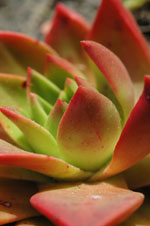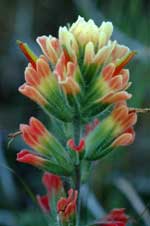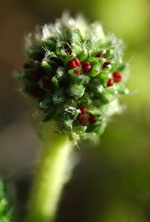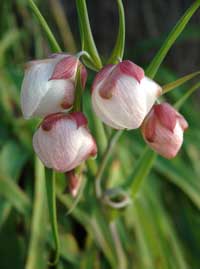A Journey Through the Scott Creek Watershed
 Gulches
Gulches
 Just inland from Highway 1 we encounter deep, erosion-sculpted gulches running perpendicular to the coastline,
their west-facing slopes home to the locally rare Alaska rein orchid (Piperia unalascensis). These isolated populations of this
widespread orchid are closer in overall gestalt to the type specimen described from material collected on the Aleutian Islands!
Just inland from Highway 1 we encounter deep, erosion-sculpted gulches running perpendicular to the coastline,
their west-facing slopes home to the locally rare Alaska rein orchid (Piperia unalascensis). These isolated populations of this
widespread orchid are closer in overall gestalt to the type specimen described from material collected on the Aleutian Islands!
While picking our way through the coastal scrub, we can observe cryptic populations of Indian paintbrush (Castilleja affinis subsp. affinis), Davy's centaury (Zeltnera davyi), minute-flowered cryptantha (Cryptantha micromeres), sea lettuce (Dudleya caespitosa), and coffee fern (Pellaea andromedifolia) that sandwich the prairie front and back. A ridge of uplifted and fractured mudstone hosts a trio of triphysarias: specifically butter-and-eggs (T. eriantha subsp. eriantha), purple-beaked owl's clover (T. micrantha), and dwarf owl's clover (T. pusilla), plus sporadic hybrids between T. eriantha and T. pusilla.
Big Willow Gulch

More or less midway between Greyhound Rock and Scott Creek Beach, Big Willow Gulch meanders from the interior grassland through the coastal prairie down into a bifurcate gulch, which overall, is home to more than 200 species, subspecies, varieties, and forms of native plants—several extremely rare. Beginning at the center of Cal Poly's Swanton Pacific Ranch, where thymeleaf beardstyle (Pogogyne serpylloides), a native mint so diminutive in stature that an adult plant can fit on the head of a dime, shares seasonally wet grassland cover with two native relatives of the domestic carrot, coast coyote thistle (Eryngium armatum) and Gairdner's yampah (Perideridia gairdneri subsp. gairdneri).
 The best way to describe Big Willow Gulch is as follows: Imagine taking floristic elements from all of the habitats within the Scott
Creek Watershed, place them in a giant blender, add water, liquefy, and spill the contents randomly throughout the entire drainage area.
Tanbark oaks (Notholithocarpus densiflorus var. densiflorus) co-mingle with California sagebrush (Artemisia californica).
Salal (Gaultheria shallon) and coast barberry (Berberis pinnata subsp. pinnata) are a stone's throw from sea thrift (Armeria
maritima subsp. californica), Monterey pine (Pinus radiata), California acaena (Acaena pinnatifida var.
californica), and San Francisco campion (Silene verecunda subsp. verecunda). Banded owl's-clover (Castilleja
exserta subsp. latifolia) with its cobwebby indument and the vanilla-scented owl's-clover (formerly recognized as Orthocarpus densiflorus
var. noctuinus and now included in Castillejadensiflora subsp. densiflora), share the same exposed/eroded grass-contoured terrace
with the myriad
The best way to describe Big Willow Gulch is as follows: Imagine taking floristic elements from all of the habitats within the Scott
Creek Watershed, place them in a giant blender, add water, liquefy, and spill the contents randomly throughout the entire drainage area.
Tanbark oaks (Notholithocarpus densiflorus var. densiflorus) co-mingle with California sagebrush (Artemisia californica).
Salal (Gaultheria shallon) and coast barberry (Berberis pinnata subsp. pinnata) are a stone's throw from sea thrift (Armeria
maritima subsp. californica), Monterey pine (Pinus radiata), California acaena (Acaena pinnatifida var.
californica), and San Francisco campion (Silene verecunda subsp. verecunda). Banded owl's-clover (Castilleja
exserta subsp. latifolia) with its cobwebby indument and the vanilla-scented owl's-clover (formerly recognized as Orthocarpus densiflorus
var. noctuinus and now included in Castillejadensiflora subsp. densiflora), share the same exposed/eroded grass-contoured terrace
with the myriad  polychromatic phases of Indian paintbrush (Castilleja affinis subsp. affinis).
Red alder (Alnus rubra), American dogwood (Cornus sericea subsp. sericea), California buckeye
(Aesculus californica), wax myrtle (Morella californica), and Utah service-berry (Amelanchier utahensis) oversee
ancientclumps of giant chain fern (Woodwardia fimbriata), tussocks of California fescue (Festuca californica), Franciscan coyote mint
(Monardella villosa subsp. franciscana), fairy lantern (Calochortus albus, a localized dwarfed race), California huckleberry
(Vaccinium ovatum), wedge-leaved horkelia (Horkelia cuneata var. cuneata), and the creeping tinker's penny (Hypericum
anagalloides). High above this botanical fray, the small annual chia (Salvia columbariae) coexists in a wind-abraded, parched abode of
dry, fractured mudstone with the uncommon Mount Diablo cottonweed (Micropus amphibolus) and the rare Santa Cruz microseris (Stebbinsoseris
decipiens).
polychromatic phases of Indian paintbrush (Castilleja affinis subsp. affinis).
Red alder (Alnus rubra), American dogwood (Cornus sericea subsp. sericea), California buckeye
(Aesculus californica), wax myrtle (Morella californica), and Utah service-berry (Amelanchier utahensis) oversee
ancientclumps of giant chain fern (Woodwardia fimbriata), tussocks of California fescue (Festuca californica), Franciscan coyote mint
(Monardella villosa subsp. franciscana), fairy lantern (Calochortus albus, a localized dwarfed race), California huckleberry
(Vaccinium ovatum), wedge-leaved horkelia (Horkelia cuneata var. cuneata), and the creeping tinker's penny (Hypericum
anagalloides). High above this botanical fray, the small annual chia (Salvia columbariae) coexists in a wind-abraded, parched abode of
dry, fractured mudstone with the uncommon Mount Diablo cottonweed (Micropus amphibolus) and the rare Santa Cruz microseris (Stebbinsoseris
decipiens).
All photographs © Dylan Neubauer
